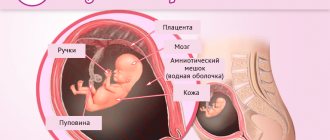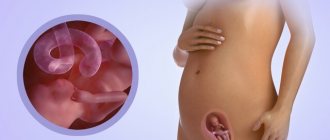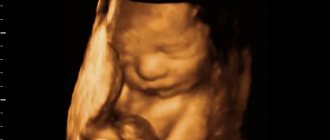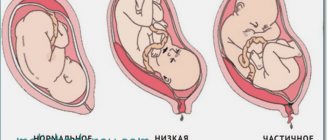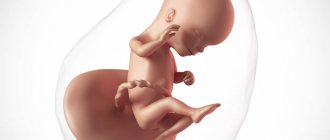Baby at 33 weeks of pregnancy
The development of the fetus at the 33rd week of pregnancy has not yet reached the required level, since some systems still continue to improve their properties and functions. Subcortical and cortical centers develop in the brain, and the number of neural connections increases due to an increase in the number of nerve fibers. The digestive system is already ready to process the milk that the baby will receive immediately after birth, but it will take a long time to improve. The cardiovascular system is also actively developing. The tone of the blood vessels and the thickness of their walls are already much greater than in the initial stages of the baby’s development. The respiratory system, if suddenly the baby is born after 33 weeks, will be ready to carry out its function independently. Subcutaneous fat continues to accumulate, which will allow the small body to fully carry out the function of thermoregulation. The fetus at 33 weeks of gestation is already much stronger, because its musculoskeletal system is growing and strengthening: bones become stronger, and muscle mass increases in volume.
It is worth noting that the bones of the baby’s skull must maintain their mobility until birth, so that passage through the birth canal is comfortable for him. This is ensured by the fact that the bones do not grow together and during the birth process they can shift slightly and overlap each other. Hardening of the interosseous sutures will occur some time after birth.
A child at 33 weeks of pregnancy is already smiling, but this smile is not yet conscious, like the reflexes that he has already acquired during development.
This week the fetus should already be in the position from which it will be born. Normally this is a cephalic presentation. It may also be that the baby is now in a breech position. To correct this, you need to perform special exercises, so hurry up and discuss this topic with your gynecologist.
The weight of a child at the 33rd week of pregnancy reaches 2000 g, however, due to the fact that each baby’s development is individual, the increase in body weight may be less or more. The fetal body length is 43-44 cm, and the heart rate is still in the range from 120 to 160 beats per minute.
Week 33Your baby is the size of a pineapple
Mother. Changes in the psychological and physical state of the body at 33 weeks
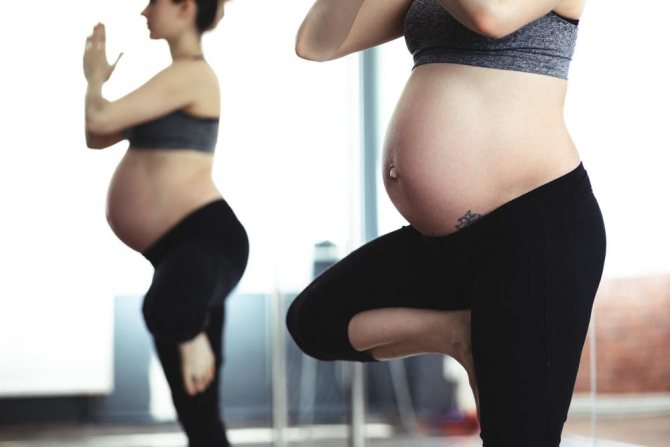
At the 33rd week of pregnancy, most expectant mothers feel satisfactory. The woman is worried about the signs of her period, but she has already gotten used to most of them:
- frequent urination;
- shortness of breath and a feeling of tightness in breathing;
- persistent desire to scratch the belly;
- the appearance of heartburn, heaviness in the stomach, flatulence if the diet is not followed;
- discomfort in the back and legs after a walk;
- difficulty falling asleep;
- fast fatiguability;
- drowsiness and absent-mindedness.
These signs are normal for the current stage of pregnancy. They are caused by an enlarged uterus, which puts pressure on all surrounding organs.
The woman’s task at the 33rd week is not to miss changes that may pose a potential danger. A woman should consult a gynecologist if she notes:
- burning or pain during urination;
- a sharp change in the color of urine, the appearance of flakes in it, a decrease in its transparency;
- pain in the kidney area (on the sides of the lower back);
- the appearance or intensification of swelling of the legs, arms, face;
- leg cramps at night or during the day;
- discomfort in the back of the head, headaches;
- exacerbation or appearance of hemorrhoids (pain in the anus);
- the appearance of spider veins on the legs, exacerbation of varicose veins of the legs;
- dizziness with nausea;
- a sharp deterioration in appearance: hair loss, layering of nail plates, skin laxity.
These manifestations do not necessarily indicate the presence of a serious pathology, but it is necessary to be on the safe side. It is advisable to make an appointment with a gynecologist monitoring the pregnancy in the coming days, having previously taken blood and urine tests.
Psychological condition
The closer the preliminary date of birth of the baby is, the more often the expectant mother thinks about this event and subsequent changes in life. It’s good if thoughts are only positive. But quite often a woman is faced with fears that can not only ruin her mood, but also affect the general condition of the pregnant woman. Taking control of your emotions in a timely manner and overcoming emerging fears is an important step in preparing for childbirth.
Most often, a pregnant woman has fears:
- pain during childbirth. They usually arise after stories from women who have previously given birth. To overcome fears, it is recommended to: ask women from your immediate circle not to talk about their experiences. Each pregnant woman is unique and experiences the most important moment of the birth of a child in her own way. It should be remembered that this process is provided by nature and has been studied by many obstetricians. To go through this stage as comfortably as possible, you should prepare in advance (psychologically adjust, study breathing techniques, attend courses for expectant mothers) and carefully listen to the instructions of doctors;
- explore possible options for pain relief (medicinal and non-medicinal). It is ideal to talk about this with your gynecologist at your next appointment;
- consider the option of joint childbirth (if it is possible in the selected health care institution). The presence of a loved one nearby, according to many women in labor, helps psychologically.
- If doctors have no reason to believe that the pregnancy is proceeding with complications, then you should not think about such options. You need to continue to take the necessary tests, visit the gynecologist in a timely manner, follow the diet and safety rules;
- In order not to be afraid of forgetting the things you need in the maternity hospital at home, this week you should find out the list of possible items in a particular maternity hospital and collect 3 sets of things: 1. for childbirth; 2. for the duration of your stay in the maternity hospital; 3. for discharge;
A woman must remember that the baby already feels emotions and takes them over from the mother. You should strive to remain calm and in a good mood. Most fears appear where there is no clear understanding of how the issue can be resolved. It is advisable not to panic, but to delve into the “problem” in order to find the most suitable solution.
Changes in the body of the expectant mother
At 33 weeks of pregnancy, a pregnant woman is unlikely to describe her state of health as excellent. An enlarged belly places a high load on the bones and muscles of the back and legs. The uterus constrains the organs that are located below, on the side and above, which affects their activity. And the psychological state in the third trimester cannot be called stable. Worries about the upcoming birth and the health of the baby are largely due to the increased amount of hormones in the blood of the expectant mother.
Belly at 33 weeks pregnant
Where does it seem to grow? But the tummy continues to increase in size, because the baby is still gaining weight. For now, the stomach is noticeably propping up the ribs, which can bring discomfort to the pregnant woman, but very soon it will drop. This is due to the fact that the baby takes a head down position, and after some time the uterus with the amniotic sac drops slightly. So soon the ribs will experience less pressure, and breathing will be much easier.
Pulling in the lower abdomen at 33 weeks of pregnancy
If from time to time your stomach “turns to stone” or your lower abdomen pulls, do not forget that this could be training contractions, through which the uterus prepares for childbirth. They should not be painful, and you also need to monitor their frequency. If the time between these contractions gradually decreases, watery discharge appears, or all this is accompanied by pain, we can assume the onset of labor. In this case, do not panic, take the things you have prepared (have you already packed the necessary things for the maternity hospital?) and call an ambulance.
Discharge at 33 weeks of pregnancy
Towards the end of pregnancy, it is especially important to monitor the nature of the discharge, since any change in it may indicate some processes in the woman’s body. In some cases it is necessary to take immediate action.
Thus, discharge that is odorless and does not differ in any color is considered normal. At the same time, they should be homogeneous in consistency. What should a pregnant woman be wary of?
- White, curd-like discharge accompanied by itching. This is how candidiasis (thrush) can manifest itself, which must be treated before the baby is born.
- Green discharge with an unpleasant odor. They indicate the presence of an inflammatory process in the body. It also needs to be identified and treated so that the disease does not affect the health of the child and the pregnant woman herself.
- Blood in the discharge. Sometimes blood appears on the pad if there are cracks in the intestinal mucosa or hemorrhoids. But if bloody discharge appears directly from the vagina, then you should call an ambulance, because blood can be released during placental abruption. When it is presented, this is even more likely to happen.
- Watery discharge. If there are not very many of them, we can talk about water leakage. In the case when their number is large enough, it is worth assuming the onset of labor. And if in the first case a woman needs to go to an antenatal clinic, where she can be given a referral to a hospital, then in the second case there is no need to hesitate - when the water breaks, you need to immediately go to the maternity hospital.
- Mucus discharge . If their amount can be measured with one tablespoon, then it may be a mucus plug. Its departure also indicates the onset of labor.
Movements at 33 weeks of pregnancy
Despite the fact that the baby becomes cramped, he continues to actively move and move in the mother’s womb. Any movement of his is now noticeable from the outside. A pregnant woman should still monitor the activity of her baby so that its changes do not go unnoticed. When the baby stops moving or his movements become too active, it is necessary to undergo a series of examinations to identify the problem.
Childbirth at 33 weeks of pregnancy
The birth of a baby before 37 weeks inclusive is considered premature. This is due to the fact that not all systems of his body are fully formed. And yet, the birth of a child at this stage is no longer considered critical. Yes, his body weight suggests that he is premature, and his body could still develop for some time in the mother's womb. However, it is safe to say that such babies are more likely to survive if they are under medical supervision for some time.
Caesarean section at 33 weeks of pregnancy
A caesarean section at this stage is usually performed urgently. Most often, the indication for this operation is developing gestosis. This condition is dangerous for the life of mother and baby, but for some reason many pregnant women believe that their task is to carry the child to 40 weeks, no matter what. But doctors say that delivering a premature baby is easier than saving the lives of both, especially when gestosis has developed to the last degree of severity. Therefore, if you have doubts about whether to agree to a caesarean section according to indications or not, it is better to give your consent. Your life and the life of your child depend on the decision you make.
Risk factors
At the 33rd week of pregnancy, there is a high risk of placental abruption. Normally, this should occur at the end of labor, but in some cases this process begins much earlier. The placenta may detach partially or completely. In this case, severe abdominal pain occurs and bloody discharge from the vagina appears. This condition is dangerous due to large blood loss for the mother and suffocation for the baby, since without the placenta, oxygen ceases to flow to the fetus.
Another problem of 33 weeks of pregnancy is late toxicosis, which also causes oxygen starvation of the child. To avoid such problems, monitor your health and be sure to inform your doctor about any changes.
Ultrasound at 33 weeks of pregnancy
The third ultrasound examination should be performed from 30 to 34 weeks of pregnancy. If you haven't had an ultrasound yet, you can do it at 33 weeks. When determining the size of the baby, the ultrasound specialist evaluates the same indicators as in the second study. Using the results obtained, the doctor determines the correspondence of fetal development to the gestational age. If last time it was not possible to determine the gender of the baby, now the doctor will tell you for sure whether you have a boy or a girl. Particular attention should be paid to the amount of water and the position of the fetus and placenta in the uterus. Also an important indicator is the degree of maturity of the placenta. If premature aging is noticed, doctors take the necessary measures to prevent intrauterine growth retardation. In addition, you need to look at the condition of the cervix in order to prevent its shortening and softening.
Ultrasound photo at 33 weeks of pregnancy
Medical observation
If you haven't had your third routine ultrasound yet, do it now. During the examination, the doctor will evaluate the development and position of the fetus, the condition of the placenta and umbilical cord. To make sure that the pregnancy proceeds without complications, the specialist will measure your blood pressure and weight, examine your arms and legs for swelling and varicose veins, listen to the fetal heartbeat, and take a smear for analysis. As always, you will need to donate blood (at this stage it is especially important to monitor sugar levels) and urine (one of the key indicators is protein content).
Necessary studies and analyzes
As always, before visiting the antenatal clinic you need to take the prescribed tests. Every 2 weeks, a pregnant woman undergoes a general urine test, and, if necessary, a blood test. When the doctor notices symptoms that need to be confirmed by other tests, she prescribes them additionally. Also, at 30 weeks of pregnancy, the woman had to undergo fetal cardiotocography, which shows the quality of the baby’s cardiovascular system. If some indicators were not normal, or this examination was not carried out for certain reasons, you need to do a CTG at 33 weeks of pregnancy.
When examining a woman, the doctor will definitely check weight gain and blood pressure. If both indicators increase, as well as the presence of protein in the urine, we can conclude that gestosis has begun. In this case, it is necessary to examine the woman for edema. In addition, the gynecologist uses a stethoscope to listen to the baby’s heartbeat and take measurements of the abdominal circumference and the height of the uterine fundus. If the doctor identifies certain pathological symptoms or the results of tests and studies indicate this, the pregnant woman will be sent to a hospital.
Indicators of the child’s body
Using a small sensor from which ultrasonic waves emanate, you can examine at least 16 parameters characterizing the general condition of the baby.
Weight category
The average weight varies from 1850 g to 2300. However, deviations from the generally accepted value are not always a cause for concern. It is worth noting that the indicator under consideration directly depends on the BMI (body mass index) of both parents: if we are talking about a fairly large physique, the mark can exceed 2500–3000 g, and if it is fragile, then the parameter will be in the range of 1300–1600 g.
Height
Based on the ultrasound results, growth is also determined (not to be confused with the coccygeal-parietal size of the fetus). So, 40–43.5 cm is quite the optimal option. A slight error of 3–5 cm is allowed towards both the minimum and maximum.
Heart rate
Carrying out CTG (cardiotocography) in parallel with the ultrasound process allows you to calculate the exact digital index of heart rate or the number of heart muscle beats in 1 minute.
It is generally accepted that normal values equate to a period from 120 to 160 beats/min. ± 5 units. When the rate drops below 100, they speak of bradycardia; an increase from 170–175 is called tachycardia. Both cases require additional types of examination that will fully clarify the situation.
Head and abdominal circumference
In order to verify the proportional structure of a small body, a specialist uses ultrasound to identify a number of measurements, which include the circumference of the tummy and head. The first parameter should be 258–336 mm, the second – 285–335 mm. In the third trimester, the baby's head has already reached its normal harmonious size.
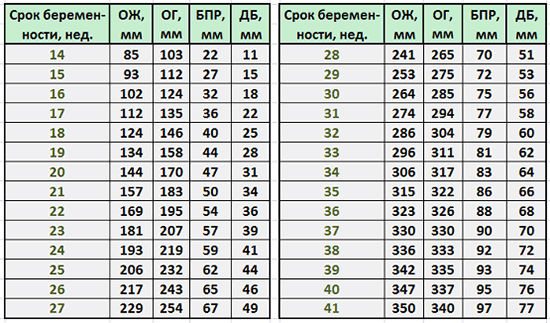
Results of measurements of coolant and exhaust gas during ultrasound
Chest diameter
Another classic indicator is DHA. The special comparative table shows a norm of 83–88 mm.
LZR and BPR
Two values related to each other determine the general structure of the child’s head. Thus, the LZR (fronto-occipital size) is a segment connecting the middle of the occipital bone with the frontal bone. BDP (bipariental size) is the distance between the parietal bones or, to put it simply, the width of the head.
| Indicator name | Norm (mm) | Allowable fluctuation (mm) |
| BPR | 80–85 | 75–91 |
| LZR | 102–109 | 95–115,5 |
Position in the womb
An extremely important factor influencing the tactics of childbirth is the location of the fetus in the mother's womb. If there is a so-called cephalic presentation detected on an ultrasound, then the birth is carried out in the classical way.
Indicators of fetal condition on CTG
Sometimes the baby takes less suitable positions:
- Transverse (perpendicular to the spine).
- Mixed (hips and knees bent at the same time).
- Gluteal (buttocks rest on the mother’s pelvic bones).
- Foot (legs pointing down).
There is an opinion that each of the listed cases requires only a cesarean section, but this is not entirely true. There are known medical facts that indicate the natural normalization of the child’s position even at such a late stage without any intervention.
Absence/presence of umbilical cord entanglement
The norm characteristic of 33-34 weeks of pregnancy practically does not allow the child to be entangled in the umbilical cord. The reason for this is the increased likelihood of fetal hypoxia, which is observed with numerous intrauterine loops. The presence of a single half-loop without tension is the only exception and is not a cause for concern.
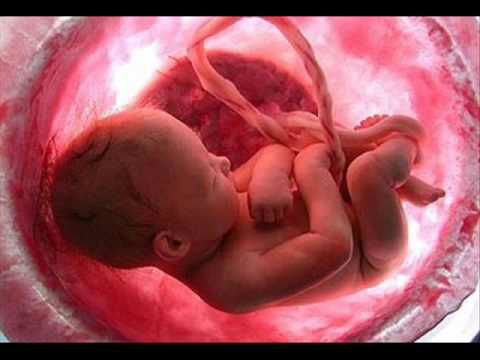
Acceptable loop encircling the right leg
Nasal bone
This facial bone must be measured during an ultrasound scan, since in some cases it is an indicator of the presence or absence of Down syndrome. The average value is equivalent to 11.3–11.5 mm. If the detected figure reaches 9 mm or increases to 13.8 mm, then do not panic. Such variations are only a manifestation of individuality, not pathology.
Length of tubular bones
Elongated round bones include the hips, forearms, shoulders, and shins, consisting of the tibia and fibula. The combination of these 4 values reflects the condition of the musculoskeletal system:
| Name of bones | Allowable length (mm) |
| Shin | 83–85 |
| Hip | 63–65 |
| Forearm | 48–50 |
| Shoulder | 56–58 |
Anatomical features
In the form with ultrasound indicators, you can often find data reflecting the development of certain organs, facial structures, as well as bone elements. These include:
- nasolabial triangle;
- lungs;
- kidneys;
- spine;
- cerebellomedullary cistern;
- bladder;
- eye sockets;
- lateral ventricles of the brain;
- stomach;
- cerebellum;
- 4-chamber section of the heart.
The absence of violations is recorded using various entries in the corresponding columns - “no pathologies”, “b/p”, “examined”, “norm” or “+”. If the sonologist identified some abnormality during the ultrasound session, he will describe it in detail on the form.
Possible problems
Problems that have already become common include various painful sensations in different parts of the body. They will mostly go away after childbirth, as the load in the form of the abdomen will go away and the pressure of the uterus on nearby organs will decrease. You already know how to deal with constipation, how to prevent varicose veins and edema, and how to cope with heartburn. Therefore, we will consider more serious problems that you may encounter due to certain circumstances.
- Preeclampsia. This condition can occur in the third trimester of pregnancy and is characterized by certain symptoms. These are high blood pressure, swelling and protein in the urine. Nausea at 33 weeks of pregnancy, as well as dizziness and weakness may just be a consequence of high blood pressure. Swelling can be determined visually, and their presence is also checked using finger pressure (if a dimple appears and it lasts for some time, it means there is edema). Excessive weight gain also indicates edema. In this case, doctors usually recommend that the pregnant woman adjust her diet, control the amount of fluid she drinks and reduce the amount of salt. If the swelling does not go away, but only intensifies, protein is detected in the urine in subsequent tests, and high blood pressure increases or persists, urgent hospitalization is necessary. Sometimes gestosis can develop so much that the only way to get rid of it and save the lives of mother and child is an emergency delivery (caesarean section).
- Oligohydramnios at 33 weeks of pregnancy. There are many reasons for the occurrence of this phenomenon: metabolic disorders in a pregnant woman, fetal kidney pathology, leakage of amniotic fluid, high blood pressure, dehydration, viral diseases, and others. There are moderate and severe oligohydramnios. In the first case, you can get by with proper nutrition, physical activity and vitamins, but in the second, drug therapy is required. But if this problem was identified in a timely manner, then you should not worry too much.
How does the mother’s well-being change?
At the thirty-third week, some pregnant women are concerned about shortness of breath , which can intensify even with minor physical activity or in a horizontal position of the body. It is due to the fact that the enlarged uterus puts pressure on the diaphragm, compresses the pliable lung tissue and reduces tidal volume. This condition forces a woman to spend most of her time half-sitting.
Interestingly, after 37-38 weeks, when the baby’s head drops into the pelvis, breathing will become much easier. It’s not for nothing that many pregnant women say that about a week before giving birth they begin to feel much better.
At this time, many women experience swelling of the fingers , which occurs in the morning. The main cause of this condition is impaired lymphatic drainage due to compression of the veins by the enlarged uterus. In this regard, expectant mothers have to temporarily part with their rings, including their wedding rings. Don’t be sad, soon after giving birth everything will return to normal.
Even at this time, experts recommend moderate physical activity if there are no contraindications. It will help cope with many troubles, improve blood circulation, reduce back pain, and slow down excess weight gain. Yoga and special group exercises in water for pregnant women are optimal in the thirty-third week. Regular swimming is also suitable, the main thing is not to overdo it and try not to swim on your back.
When playing sports, it is necessary to observe the rules of personal hygiene, because the expectant mother’s body is still very vulnerable, and an infection can greatly harm the baby.
- The baby is almost ready to be born, but its lungs are still immature and there is a risk of developing neonatal respiratory distress syndrome.
- A child's weight and height can vary significantly, so doctors use centile tables.
- Mom's fingers often swell, especially in the morning. This is not a pathology and will definitely go away after childbirth.
- If there are no contraindications, you can do yoga and swimming, the main thing is not to overwork.
- Some pregnant women think about going to hospital under the supervision of doctors, but this is not always justified.
Recommendations for expectant mothers
- Rest. Adequate rest and sleep can provide support to an already weakened immune system, as well as slightly reduce fatigue. If you have trouble falling asleep, ventilate your room before going to bed, don't eat a couple of hours before bed, and choose a comfortable position using pillows.
- Continue to eat healthy. This way you will provide your body, as well as your baby, with all the necessary macro- and microelements, and also will not create problems with excess weight and constipation.
- Don't give up physical activity. If your health allows, do Pilates or swim. If it’s already quite difficult to move, you can walk in the fresh air, which will also have a positive effect on both your health and mood.
- If you have not yet collected all the necessary things for the maternity hospital , do it soon so as not to think about it. And in extreme cases, you won’t have to run in a hurry.
- Control your well-being. It is especially important to do this in the last stages of pregnancy. By following all the doctor’s recommendations, undergoing the necessary examinations, and also monitoring your condition, you will significantly reduce the risk of serious problems.
Changes and sensations in the mother’s body
The last months of pregnancy are a very difficult time for a woman, both physically and emotionally. Previously familiar activities are becoming increasingly difficult: long walks and gatherings, shopping and household chores. Lower back pain and swelling are becoming more and more common. But despite all the troubles, the expectant mother receives great pleasure, feeling her baby under her heart. For parents expecting girls and expecting boys, the feeling of moving in the tummy will forever be remembered as the most vivid memory of pregnancy.

